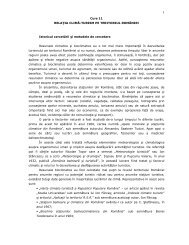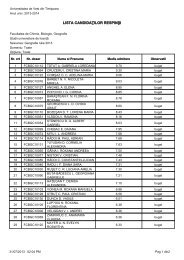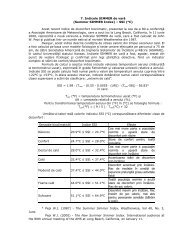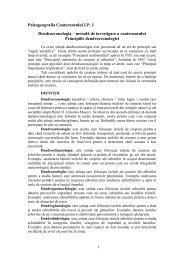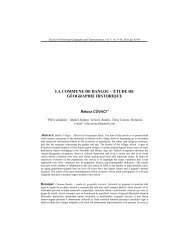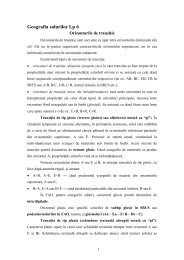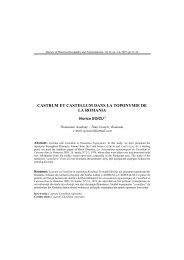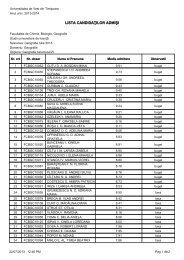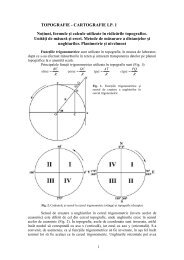villa florio from favignana island - Departamentul de Geografie
villa florio from favignana island - Departamentul de Geografie
villa florio from favignana island - Departamentul de Geografie
Create successful ePaper yourself
Turn your PDF publications into a flip-book with our unique Google optimized e-Paper software.
Review of Historical Geography and Toponomastics, vol. VII, no. 13-14, 2012, pp. 89-112<br />
VILLA FLORIO FROM FAVIGNANA ISLAND:<br />
ARCHITECTONIC AND FUNCTONAL HISTORY<br />
Grazia VECCHIO*<br />
* Doctor in Philosophy of Geography and Lecturer, University of Catania, Faculty<br />
of Literature and Philosophy, Department of Humanistic Sciences,<br />
Monastero <strong>de</strong>i Bene<strong>de</strong>ttini, No. 32, 95124, Catania, Italy<br />
email: vecchio_grazia@tiscali.it<br />
Abstract: Villa Florio <strong>from</strong> Favignana <strong>island</strong>: architectonic and functional history. The far Sicilian<br />
West which, besi<strong>de</strong>s the Egadi <strong>island</strong>s, inclu<strong>de</strong>s the area between Marsala and Trapani is characterized<br />
by a specific landscape and socio-economic unity. In this context, the <strong>island</strong> of Favignana may be<br />
consi<strong>de</strong>red as the last vertex of a hypothetical economic-industrial triangle (Palermo – Marsala/Trapani<br />
– Favignana) characterized by a whole series of activities referable to the bourgeois house of Florio,<br />
one of the most powerful in Sicily <strong>from</strong> the second half of 19 th century to the first <strong>de</strong>ca<strong>de</strong>s of 20 th . In<br />
the area un<strong>de</strong>r examination it is in Favignana that, after having bought the Egadi in 1874, they had<br />
Villa Florio built by G. Damiani Almeyda. At the same time this was inten<strong>de</strong>d to be an official country<br />
house and link with their tuna fisheries which were then the first industry in the Mediterranean and<br />
now significant testimony of industrial archaeology. Starting <strong>from</strong> the architectonic and functional<br />
history of the Villa and tuna fisheries and passing to an analysis which through the Florio family<br />
events, connected to those of some great English entrepreneurs, outlines their ascent and <strong>de</strong>cline, in<br />
this paper we aim at reconstructing the interconnection between the Florio enterprises and the history<br />
of the aforesaid territory in relation to that of Sicily. This history has been highly influenced by the<br />
process of accumulation that in the 19 th century allowed these few figures of entrepreneur-financiers to<br />
start the first Sicilian industrialization. Moreover, the fact that this resi<strong>de</strong>nce not only had its typical<br />
official function but had also assumed an economic one, clearly symbolizes the un<strong>de</strong>rwent passage<br />
<strong>from</strong> the hegemony of the old aristocracy to that of the rising middle-class.<br />
Rezumat: Vila Florio din insula Favignana: o istorie arhtectonică şi funcţională. Vestul în<strong>de</strong>părtat<br />
al Siciliei, care pe lângă insulele Egadi inclu<strong>de</strong> şi aria dintre Marsala şi Trapani, este caracterizat<br />
printr-un peisaj particular şi printr-un potenţial socio-economic unitar. În acest context, insula<br />
Favignana poate fi consi<strong>de</strong>rată vârful ipotetic al unui triunghi spaţial (Palermo – Marsala/Trapani –<br />
Favignana) caracterizat printr-o serie <strong>de</strong> activităţi referitoare la casa burgheză Florio, care a găzduit
Grazia VECCHIO<br />
una dintre cele mai puternice familii din Sicilia <strong>de</strong> la cumpăna dintre secolele al XIX-lea şi al XX-lea.<br />
În acest spaţiu <strong>de</strong> analiză se află Favignana, un<strong>de</strong> remarcăm vila Florio, construită <strong>de</strong> G. Damiani<br />
Almeyda. Aceasta se dorea o reşedinţă <strong>de</strong> ţară cu un <strong>de</strong>stin strâns legat <strong>de</strong> activităţile piscicole şi cele<br />
industriale incipiente din Bazinul Mării Mediteraneene, astăzi fiind o mărturie reală a arheologiei<br />
industriale din aceste locuri. Pornind <strong>de</strong> la istoria arhitecturală şi <strong>de</strong> la funcţionalitatea acestei reşedinţe<br />
şi trecând în revistă evenimentele particulare familiei Florio conectate la antreprenorii englezi, vom<br />
încerca să relevăm ascensiunea şi <strong>de</strong>că<strong>de</strong>rea precum şi reconstrucţia conexiunilor dintre întreprin<strong>de</strong>rile<br />
patronate <strong>de</strong> familia Florio şi dinamica spaţiului sicilian. Istoria acestor realităţi a fost influenţată <strong>de</strong><br />
procesele <strong>de</strong> acumulare specifice secolului al XIX-lea, care au permis şi favorizat reprezentanţilor<br />
acestei familii <strong>de</strong>butul primelor faze <strong>de</strong> industrializare siciliană. Mai mult <strong>de</strong>cât atât, faptul că această<br />
reşedinţă a avut şi o funcţie economică alături <strong>de</strong> cea <strong>de</strong> reşedinţă oficială, simbolizează în mod cert<br />
trecerea <strong>de</strong> la hegemonia vechii aristocraţii spre conturarea clasei <strong>de</strong> mijloc la nivelul regiunii siciliene.<br />
Keywords: history, Villa Florio, aristocracy, Favignana.<br />
Cuvinte cheie: istorie, Vila Florio, aristocraţie, Favignana.<br />
1. INTRODUCTION<br />
The rather small distance that divi<strong>de</strong>s the part of western Sicily which has Palermo<br />
and the Conca d’Oro at its centre <strong>from</strong> the farthest strip of the Sicilian West, characterized<br />
by a low terrace whose coasts between Trapani and Marsala through the Sicily Channel<br />
overlook the Mediterranean Sea, doesn’t prevent the latter <strong>from</strong> outlining a territory which<br />
differentiates itself <strong>from</strong> the area of Palermo in or<strong>de</strong>r to form a specific and homogeneous<br />
landscape and socio-economic unity. This vast tableland area, which spreads as far as the<br />
coast and which is <strong>de</strong>limited to the north by mount S. Giuliano fringes first in the Isole <strong>de</strong>llo<br />
Stagnone, where lies the ruins of Mothia, and then in the archipelago of the Egadi which<br />
inclu<strong>de</strong>s the <strong>island</strong>s of Favignana, almost equidistant <strong>from</strong> Marsala and Trapani, Levanzo,<br />
Marettimo and finally the islets of Formica and Maraone. Favignana the most southern and<br />
largest among all, called Aegusa until it assumed the Latin appellation of Favoniana, whose<br />
etymological <strong>de</strong>rivation is probably related to the constant presence of the wind on the<br />
<strong>island</strong>, is referred to also as «the <strong>island</strong> of the tuft» and «the queen of tuna fisheries», and is<br />
characterized by having the shape of a butterfly, on which a mountainous rib stands out, with<br />
two large plains stretching eastward and westward.<br />
During one of its periods of maximum splendour between the 19 th and 20 th<br />
centuries, the economic history of this area was highly influenced by the enterprises of a<br />
powerful family, the Florio, which together with some great English tra<strong>de</strong>rs settled in Sicily<br />
affected the industrial and agricultural <strong>de</strong>velopment of Marsala, and in a some peculiar way<br />
that of Favignana. Therefore, Favignana may be consi<strong>de</strong>red as the last vertex of a<br />
hypothetical economic-industrial triangle in which the other two are ma<strong>de</strong> up of the city of<br />
Palermo and of those of Marsala and Trapani together, and whose area is characterized by a<br />
whole series of activities referable to the Florio; these range <strong>from</strong> the wine industry, for<br />
which Marsala has represented one of the main Sicilian poles, to the saltworks of Trapani,<br />
<strong>from</strong> the shipping companies of Palermo, of which the Florio, as owners, took advantage of<br />
for the carriage and export of their products, to the very ancient ones of the tuna fisheries<br />
which reached their peak prosperity in Favignana. In this area, the consonance among the<br />
mentioned sectors of the economic <strong>de</strong>velopment and the harmony of elements as the snowwhite<br />
saltworks grid, the windmills with their double connotation given by their functional<br />
90
Villa Florio in Favignana <strong>island</strong>: architectonic and functional history<br />
and aesthetic values, the storehouses of the tuna fisheries, the bagli and the endless rows of<br />
vineyards have taken the form of a spontaneous environmental architecture in which the<br />
prevalence of the horizontal dimension and of the interpenetration among the natural<br />
elements, have integrated also the Egadi <strong>island</strong>s and the Mediterranean Sea.<br />
In such a context, set on the northern part of the <strong>island</strong> of Favignana, stands the<br />
homonymous built-up area, endowed with a port in the surroundings of which you can<br />
distinguish the extensive <strong>de</strong>nticulate outline of the saddle-roofed buildings of the Florio’s<br />
tuna fisheries, the Florio Villa, built on the site of the <strong>de</strong>molished fort of S. Leonardo and the<br />
church of S. Antonio which together seem to constitute a rather unitary architectural<br />
complex, able anyway to impose itself and to add an original connotation to the look of<br />
what, for the rest, has been above all a Mediterranean seafaring <strong>villa</strong>ge, and whose<br />
planimetric structural <strong>de</strong>sign and bare structural elements reflect up till now an authority of<br />
Arab origin.<br />
2. FLORIO VILLA AND TUNA FISHERIES - TWO<br />
ARCHITECTURES ON A LITTLE ISLAND OF THE<br />
MEDITERANEAN<br />
Villa Florio in Favignana or also “Florio Castle” (photo 1, photo 2), planned by the<br />
architect Giuseppe Damiani Almeyda (1834-1911) as a country house for the Florio family<br />
and inten<strong>de</strong>d above all to be connected to the company activities of the tuna fisheries of<br />
Favignana and Formica straight after they bought the Egadi <strong>island</strong>s (1874), can be<br />
consi<strong>de</strong>red a fundamental resi<strong>de</strong>nce junction in the area of Marsala and Trapani for the rich<br />
network of acquaintances that this bourgeois family maintained here too, through a periodic<br />
and full worldly life, at the same time complementary and alternative to that they had in their<br />
buildings in Palermo. In the area un<strong>de</strong>r examination, the palace in Favignana, in<strong>de</strong>ed, is the<br />
one expressly commissioned by the Florio, unlike what occurred for the master’s house of<br />
the baglio in Marsala that in this sense had a much more mo<strong>de</strong>st role, to accomplish the<br />
further purpose of exalting their public image; such a choice implied that this <strong>island</strong> would<br />
become their favourite place of rest and retreat, as well as point of convergence of many of<br />
their entrepreneurial affairs. In<strong>de</strong>ed, the history of the construction of Villa Florio cannot be<br />
separated <strong>from</strong> that of the tuna fisheries, which were renovated by the same Damiani who<br />
practically redrew all the seaward front of Favignana.<br />
Beginning in the latter half of the 19 th century, this engineer-architect 1 played a key<br />
role in the history of Sicilian architecture, realizing most of his works in Palermo, a city<br />
whose bourgeois aspect he contributed to by redrawing 2 . The figure of Damiani, not only<br />
consi<strong>de</strong>red an eclectic architect but also an exponent of the neo-Graecism and of the neo-<br />
Renaissance style, is a composite one owing to the fact that he had felt the effects both of his<br />
1 G. Damiani Almeyda born in Capua of a father <strong>from</strong> Palermo, studied in Naples until when in 1859 he moved to<br />
Palermo, where he held important institutional duties at the Civil Engineering Office and at the City Council. Since<br />
1878 he taught at the University of Palermo. He left various writings among which: Istituzioni ornamentali<br />
sull’antico e sul vero (1890) and its continuation Istituzioni architettoniche, still unpublished. Instead, two<br />
manuscripts were published posthumously: The History of Mo<strong>de</strong>rn Italian Art (2005) and the The Ups and Downs<br />
of My Life (2001).<br />
2 Here, among other items of his, are the plans of the Ruggero Settimo Monument and of the Teatro Politeama<br />
Garibaldi, of the restoration of the Palazzo di Città and that of the Aula Gran<strong>de</strong> of the Archivio Storico Comunale.<br />
91
Grazia VECCHIO<br />
Neapolitan education and of many European influences, first among all that of the<br />
“polychrome architecture”. Damiani is often mentioned also because «he set himself against<br />
the “mo<strong>de</strong>rnism” of Basile, with a <strong>de</strong>ep bond with classical architecture and its principles<br />
[…]» (P. Barbera, 2008, p. 7).<br />
Photo 1: Main faca<strong>de</strong> or Si<strong>de</strong> towards the city<br />
(source: Vecchio, 2011)<br />
Photo 2: Back faca<strong>de</strong> or si<strong>de</strong> towards the tuna fisheries<br />
(source: Vecchio, 2011)<br />
92
Villa Florio in Favignana <strong>island</strong>: architectonic and functional history<br />
The theme of classicism is, therefore, one to which Damiani was always interested<br />
to in a constant research work directed to make up-to-date the mo<strong>de</strong>ls of the past through a<br />
method that allowed him «to fish with an eclectic abundance <strong>from</strong> the entire succession of<br />
the history of architecture, recognizing the originality of the individual contribution»<br />
(Fundarò A.M., 1999, p. 33). Apart <strong>from</strong> the great works in Palermo, Damiani also created<br />
different plans expressly for the Florio family, with whom he first got in touch in 1865. It is<br />
noteworthy that the members of the Florio family had always entrusted great architects for<br />
the realization of artistic projects whose image became highly symbolic of their role in that<br />
age 3 and that for Damiani the most profitable collaboration 4 was that with Ignazio sr. for<br />
whom he would have worked until the <strong>de</strong>ath of the latter. In the meantime, as far as the<br />
farthest west is concerned, he would have given other important contributions with the<br />
restoration of the Marsala Cathedral (1892) and the rebuilding of its collapsed ancient dome<br />
(1893) and still in Marsala with the realization of a “memorial column to Garibaldi” (1893).<br />
The planning of Florio palace in Favignana represented for Damiani a <strong>de</strong>manding and also<br />
rather unusual commission, not only because the house architecture was one of the fields on<br />
which he had less ventured but even for the type of structural and practical <strong>de</strong>vices that<br />
building an official palace in a peripheral <strong>island</strong> could require.<br />
Thanks to the Damiani archives, where also lie the numerous letters sent to<br />
Damiani <strong>from</strong> his disciple Filippo La Porta, who was used to oversee the works in the yard<br />
of Favignana in his absence, the scholar Anna Maria Fundarò has been able to reconstruct<br />
the planning and constructional events of this building 5 . From these it appears that Damiani,<br />
who was entrusted with the task between 1874 and 1875, proposed his first outline plan in<br />
February 1875, while an epistolary evi<strong>de</strong>nce which mentions a «topography for Mr. Florio»<br />
drawn up by the engineer Simone Biuso dates back to April 1875. The <strong>de</strong>finitive plan, which<br />
was proposed to Florio in May 1875, consisted of ten Tables of which Fundarò has<br />
discovered the four pertinent to the plan of the building, each one containing the inscription<br />
«Country house in Favignana. For the “Comm.re” I. Florio» and the two tables of the<br />
sections; the tables referring to the four prospects haven’t been found yet. Apart <strong>from</strong> the<br />
Tables there also exists a plan for an octagonal gar<strong>de</strong>n, a “Ten<strong>de</strong>r” and an estimate of<br />
expenditure which together supply precious information about the techniques used and<br />
building materials. Then Damiani inserted three different tables (plans, prospect of the<br />
faça<strong>de</strong> and section) of this Villa, which he <strong>de</strong>fined Pavilion for «princely hunting lodge» in<br />
his Ornamental Architectonic Institutes; they serve not only to make manifest the<br />
importance which the author assigned to this building but above all to evaluate the stylistic<br />
changes un<strong>de</strong>rgone by the palace in the passing <strong>from</strong> what was its effective practical<br />
realization to a following abstract revision, which turned out to be more complex as well as<br />
closer to his first drafts.<br />
An eclectic work in the neo-Gothic style which overlooks Piazza Marina, this<br />
building looks like a big compact and openwork cube with smoothed voluminous areas<br />
which in some of its parts leans forward thanks to the existence of two bow-windows, the<br />
3 With regard to their contribution to Sicilian artistic <strong>de</strong>velopment, referring to mo<strong>de</strong>rnism, Sergio Troisi points out<br />
that: «The Florio […] didn’t assign to the art a task that would have gone beyond the society <strong>de</strong>corum; and they<br />
didn’t perform in this field that dynamic function that instead marked their activities in the economic sphere. In this<br />
meaning the manifestations of a showy eclecticism are then more un<strong>de</strong>rstandable […] » (Troisi S., 1985, p. 142).<br />
4 It is possible to establish a binomial link client-architect between Vincenzo and C. Giachery, between Ignazio sr.<br />
and Damiani Almeyda and finally between Ignazio jr. and E. Basile (Barbera P., 2008, p. 157).<br />
5 They have been published, together with all the extant material, in Fundarò A.M., (1999).<br />
93
Grazia VECCHIO<br />
octagonal staircase, two cuspidate turrets and a clock tower overlooking the main front. In<br />
this building Damiani seems to be willing to diverge <strong>from</strong> the Classicism and the neo-<br />
Renaissance of his public buildings to draw on the Middle Ages south (Troisi S., 1985, p.<br />
117). Even though the palace is inserted in a non-urban Mediterranean context, for some of<br />
its features it recalls more some buildings of European countries as Belgium, France, Great<br />
Britain and Germany than that of Italy, as it is pointed out by Fundarò, who reports some of<br />
the illustrations of a volume 6 to which it is likely Damiani had drawn <strong>from</strong> 7 . While in the<br />
faça<strong>de</strong>s, the main appearing stylistic marks, often medieval and gothic, are represented by<br />
the embattled cornice, double lancet windows, rose windows and by perforated parapets. As<br />
far as the four faça<strong>de</strong>s of this Renaissance palace are concerned, in front of the main and<br />
front one is situated the flight of steps which represents the main entrance and is indicated<br />
by Damiani in the pertinent plan as ”Si<strong>de</strong> towards the city”.<br />
Then you can observe the opposite faça<strong>de</strong>, the back one, named “Si<strong>de</strong> towards the<br />
tuna fisheries” which is connoted by a large iron veranda inclu<strong>de</strong>d between the bow<br />
windows corresponding to the first-floor above, and the two si<strong>de</strong> faça<strong>de</strong>s, the “Si<strong>de</strong> towards<br />
the harbour”, characterized by the projection of the semi-octagonal tower and the “Si<strong>de</strong><br />
towards south”. From the drafts going back to even before the outline plan of February 1875,<br />
in which the palace already had three floors, you can see that the original plan provi<strong>de</strong>d for<br />
just two floors which probably the architect consi<strong>de</strong>red more suitable for the urban structure<br />
of the <strong>villa</strong>ge. It may have been for living requirements that in the final version of the plan<br />
the three floors (Ground floor, Noble floor, Guestrooms, besi<strong>de</strong>s the Cava” or cellars), which<br />
have conferred to the building a greater vertical soaring, have been maintained. Furthermore,<br />
according to correspon<strong>de</strong>nce with La Porta, the building of the Villa was begun in<br />
September 1876 and, with the exception of some finishing touches, finished in May 1878.<br />
Therefore you can enter the <strong>villa</strong>, surroun<strong>de</strong>d by a little park, <strong>from</strong> the flight of<br />
steps of the ground floor, slightly raised, characterized by the three arches which lead to the<br />
Porch through which you can enter the Hall; <strong>from</strong> the latter, after having passed through the<br />
Study, situated on the right si<strong>de</strong>, you can reach the Chapel. As we can recognize <strong>from</strong> the<br />
plans of the palace, through which we can read the original specific <strong>de</strong>stination of each<br />
room, having gone beyond the Hall we can find the centre of the house which consists of the<br />
wi<strong>de</strong> and rectangular Lobby, which on the left leads to the staircase and on the right to the<br />
Library, while going on you can reach the reception Room which in its turn is connected to<br />
the Billiard Room and to the Dining Room that jutting out form the bow-windows above<br />
which opens the veranda. By means of a great flight of steps you can reach the Noble Floor<br />
which is very articulate and has at its centre the Common Hall, characterized by a rooflight:<br />
various rooms of the floor lead off it, including the Wedding Room with the “Back Room<br />
and Dressing Table for the Master”, “Back Room and Dressing Table for the Mistress” and<br />
other rooms for the maidservants, the study, a wing reserved as the two “Gentlemens’<br />
Rooms”, the Study and the room for the Tutor and a wing <strong>de</strong>dicated to “Daughters and<br />
Nursemaids”, close to the places for the servants and the housekeeper. You can reach the<br />
Guestrooms, also illuminated by a skylight, through the little staircase that leads to what also<br />
6 We refer to: PETIT VICTOR, Habitations Cosmopolites-Ducher & C., Parigi. See Fundarò A.M., 1999, p. 153.<br />
7 Fundarò highlights the points of contact among the buildings in these illustrations, each one tending to embody a<br />
particular architectonic style symbolizing a country, and Florio palace. They are given body in some <strong>de</strong>tails as the<br />
iron roofing ad<strong>de</strong>d to compact bodies, present also in a typology of Belgian houses, the cylindrical angular turrets<br />
and the cusps of the roof of the French and German houses, as well as the octagonal jutting bodies which are<br />
possible to be found in English houses (Fundarò A.M., 1999, p. 31).<br />
94
Villa Florio in Favignana <strong>island</strong>: architectonic and functional history<br />
on this floor is the centre of the house, that is the large Hall surroun<strong>de</strong>d by about eighteen<br />
rooms for the most part inten<strong>de</strong>d to carry out the function of bedrooms. As regards the<br />
interiors in which the movable furniture is no longer present and whose flooring in some<br />
rooms has been substituted during previous restoration work, the <strong>de</strong>tails concerning the fixed<br />
furniture can also be inferred <strong>from</strong> the observations written by La Porta to Damiani in the<br />
mentioned letters. One of the issues which drew La Porta’s attention most was the<br />
<strong>de</strong>coration to be reserved to the various rooms, about which Damiani, who usually<br />
particularly liked to linger over the <strong>de</strong>corative part, in this case proved to be less interested.<br />
La Porta won<strong>de</strong>red, for example, whether to use in the dining room calcareous material or<br />
tuff, about the iron banister of the inner staircase created in Oretea Foundry, the <strong>de</strong>coration<br />
of the vaults, in whose frescoes the floral subject predominated, as well as about the choice<br />
of the materials for the flooring 8 .<br />
These indications turn out to be all the more useful because the palace, having<br />
become common property of the town council has changed its <strong>de</strong>stination of use and in the<br />
last <strong>de</strong>ca<strong>de</strong> not only housed some municipal offices but also the “Antiquarium” Museum<br />
where un<strong>de</strong>rwater archaeological finds were situated. At present the <strong>villa</strong> is un<strong>de</strong>rgoing<br />
restoration work, carried out with regional funds and oriented to a new <strong>de</strong>stination of use,<br />
thanks to which it will be used as a conference room and museum.<br />
The buildings of the Favignana tuna fisheries, nearby and closely connected to<br />
Villa Florio, have a much more ancient history than that of the palace and for this reason in<br />
the last <strong>de</strong>ca<strong>de</strong>s have been the subject of various studies in the field of industrial<br />
archaeology. To the building of tuna fisheries on land, which until the period prior to the<br />
Florio had been modified in a non-systematic manner, adding new rooms whenever a need<br />
arose, Damiani, on commission of Ignazio sr., with his work of restoration and extension<br />
(1874) gave them the look which they would keep until recent years 9 , before the last<br />
renovation with which their <strong>de</strong>stination of use has been modified. 10 In or<strong>de</strong>r to un<strong>de</strong>rstand<br />
the structure of the tuna fisheries of Favignana, it is useful to consi<strong>de</strong>r that «a tuna fishery,<br />
historically <strong>de</strong>termined, is first of all, a site and the construction of a trap which remains set<br />
up some months» (Lo Curzio M., 1991, p. 13). This trap consists of a complex system of fix<br />
different sized nets, mounted during the period of tuna migration and ma<strong>de</strong> up of a basic part<br />
called isola, and of the pedale or costa 11 . The isola and the pedale are the part of tuna fishery<br />
8 Finally for some rooms such as the billiards room it was parquet, for others such as the kitchens and the passages<br />
it was “flint tiles” and for the bedrooms “tinned bricks”.<br />
9 The situation of the tuna fisheries was very effectively <strong>de</strong>scribed by Vincenzo Consolo: «By now all is flaking off,<br />
corroding and collapsing in those sheds; every plaster, wall, stone, plate or iron part is eaten up by the plague of<br />
saltiness and saltpetre […]. And in these abandoned sheds the grass doesn’t grow among the joints of the bricks, nor<br />
do ivy, brambles or moss climb up the walls; you can see neither an animal, nor mouse, lizard, gecko or spi<strong>de</strong>r: it<br />
seems that life has withdrawn <strong>from</strong> here; […]» (Consolo V., 1999, p.61).<br />
10 The presentation of the restoration works of the ex Florio Factory, property of the Sicilian Region <strong>from</strong> the<br />
nineties on, took place on 26 th September 2009. The requalification of the buildings cost fifteen million euros and<br />
financed with the POR 2000-2006 funds <strong>from</strong> the European Community, was overseen by the Cultural Estate Office<br />
of Trapani. The plan of restoration is due to the architect Stefano Biondo who also began the works in 2003, which<br />
were completed afterwards by the architect Paola Misuraca. With the restoration, whose purpose was to keep the<br />
architectural features, volumes and structural characteristic, more than two thirds of the tuna fisheries have been<br />
recovered, for a total area of about 32 thousand square metres. It has been <strong>de</strong>signed as a museum with exhibition<br />
space, conference room, additional services, guestrooms and so on. See Giornale di Sicilia, Speciale Tonnare di<br />
Favignana, 24 settembre 2009.<br />
11 The isola is subdivi<strong>de</strong>d in chambers whose walls are separated <strong>from</strong> vertical mobile nets each one representing<br />
the doors which allow the passage of tunas which are driven into the different chambers till they reach the last one,<br />
95
Grazia VECCHIO<br />
whose activity is marine and mobile. As far as the tuna fishery of Favignana is concerned it<br />
was an “outward tuna fishery” which indicated that the tunny killing occurred when the<br />
tunas completed the first cycle of their migratory journeys, ranging <strong>from</strong> May to June, and a<br />
“stand tuna fishery”, that is to say it had many chambers whose doors could be closed at<br />
will. With tuna fisheries architecture, instead, we refer to the other part of the tuna fisheries,<br />
which serves to accomplish the activities on land and which is ma<strong>de</strong> up of all the buildings<br />
of the tuna fisheries, also called as a whole malfaraggio. The last ones are inten<strong>de</strong>d to be<br />
storage for the equipment and nets, laying up of boats, conservation of the catch and<br />
sometimes also shelter for the crew of fishermen. Obviously a <strong>de</strong>ep connection exists<br />
between the sea activities and the typology of the tuna fisheries buildings on land.<br />
The reshaping of the structure on land of the Favignana tuna fisheries, characterized<br />
by a Renaissance outsi<strong>de</strong> composition and by interior ogee cross arches, for which the<br />
architect took the i<strong>de</strong>a <strong>from</strong> the English industrial buildings, ranges «<strong>from</strong> local tradition to<br />
import culture» (Terranova F., 1987, p. 61) and refers to the morphological scheme of the<br />
Sicilian baglio 12 , very wi<strong>de</strong>spread in the area of Marsala. The new configuration drawn by<br />
Damiani consisted, in<strong>de</strong>ed, of «a courtyard shaped building whose wings are <strong>de</strong>termined by<br />
the differentiated functions of the single parts […]» (ibi<strong>de</strong>m). The malfaraggio of the<br />
Favignana tuna fishery is situated between the little port of S.Leonardo and the Plaja. The<br />
entrance, which is followed by the rooms of the storehouse and administration leads to the<br />
inner courtyard (“baglio”) and is composed of three parts: the storehouse for the nets<br />
(camparia), the dockyard (trizzana) and the storehouse for the ropes and floats. The<br />
rectangular-shaped camparia has ten bays and a saddle roof. The nave insi<strong>de</strong> has ogee<br />
arches, while the aisle has round arches. The trizzana, where the boats were built and<br />
repaired, consists of two rooms with saddle-roofs with its interiors characterized by ogee and<br />
round arches too. The storehouses, situated between the camparia and trizzana, consists of<br />
three rooms where the body of the tuna fishery and all the other tools were kept. The<br />
outward appearance of the whole series of buildings of the malfaraggio, which shows an<br />
achieved balance between <strong>de</strong>corative sobriety and architectonic stateliness shows that<br />
Damiani succee<strong>de</strong>d in obtaining a compromise between his own aesthetic-structural needs<br />
and the functional <strong>de</strong>mands of the production logic of what was the first and biggest tunny<br />
fishing industry in the Mediterranean 13 .<br />
without door and <strong>from</strong> tighter and tighter meshes, that is the “chamber of <strong>de</strong>ath” where the tunny killing takes place.<br />
The isola is placed at the extremity near to the coast of the pedale, which is instead the wall of nets that starts <strong>from</strong><br />
the shore and pushes up to the open sea in or<strong>de</strong>r to cut off the tunas route.<br />
12 Between the 17th and the 18th centuries the Sicilian bagli were used above all for the conservation of cereal. It<br />
was because of the increase in vine cultivation that they become wine farms. Structurally a baglio now indicates:<br />
«the whole complex of rural buildings laid out around the courtyard and often fortified» (Maurici F. in Kalos, n. 44,<br />
1997).<br />
13 In the buildings of the tuna fisheries, in whose gar<strong>de</strong>ns two of Florio’s busts are also situated, three plaques<br />
whose inscriptions commemorate the best haul years are still in existence (1848-1853-1859). The 1848 one bears<br />
the word: «During the Lord’s year 1848- In this tuna fishery 4,345 tunas were killed - Outdoing the memorable haul<br />
of 1771- During the tallage of Mr Ignazio and Mr. Vincenzo Florio- Administrator Ribaudo - Rais Michele<br />
Casubolo».<br />
96
Villa Florio in Favignana <strong>island</strong>: architectonic and functional history<br />
3. A FAMILY OF SICILIAN ENTREPRENEURS BETWEEN THE<br />
19 th AND 20 th CENTURIES: THE FLORIO FAMILY<br />
The bourgeois house of the Florio 14 , one of the richest and most powerful in the<br />
history of Sicily <strong>from</strong> the second half of the 19 th century to the first <strong>de</strong>ca<strong>de</strong>s of the 20 th<br />
century, a period during which it became married into the high aristocracy of Palermo,<br />
comes <strong>from</strong> a Calabrian family of minor entrepreneurs, whose progenitor is recognized in<br />
Tommaso, a craftsman, perhaps a blacksmith, who was born after 1650 and lived in<br />
Melicuccà, in the neighbourhood of Bagnara Calabra. It is <strong>from</strong> he, then, that the parabolic<br />
curve of their ascent and <strong>de</strong>cline is ma<strong>de</strong> to date back (Cancila O., 2008). It is emblematic<br />
that right for its bourgeois origins this family didn’t i<strong>de</strong>ntify itself with a coat of arms but<br />
with the symbol which accompanied many of its activity, adopted afterwards in the labels of<br />
marsala that is to say the “leo bibens” 15 . In this sense although the Florio had became related<br />
both to the d’On<strong>de</strong>s Trigona family, thanks to whom they could have obtained the title of<br />
Count, and afterwards to the Lanza Branciforte, and in spite of the fact that with the<br />
purchase of the Egadi they could have acquired the title of nobility due to their owners, they<br />
were never interested to join also nominally that aristocracy that actually they took part in.<br />
Domenico, son of Tommaso, moved to the coastal town of Bagnara Calabra,<br />
practised the tra<strong>de</strong> of smith and horseshoer and began to amass small properties. Vincenzo<br />
who continued the paternal line as he was the only to have a large progeny, concentrated<br />
with his hands on a part of the real estates bequeathed by his father, by buying them <strong>from</strong> his<br />
brothers, until the earthquake that hit the Calabria in 1783 brought it all up for discussion<br />
again <strong>de</strong>stroying the possession of Vincenzo who probably in that occasion lost also his<br />
wife, as it turns out that he married again after a very short time. Among his eight children<br />
the fundamental outcome sprang <strong>from</strong> the marriage between Mattia and Paolo Barbaro who<br />
belonged to a merchants and sailors family who were used to buy goods in many<br />
Mediterranean harbours, and to resell them in others, the Tyrrhenian and Sicily ones<br />
inclu<strong>de</strong>d. Together with him another Florio brother, Paolo (1772-1807) started his activity of<br />
sea itinerant and in 1793 formed a partnership, which would have been dissolved in 1803<br />
and which had its offices in Palermo, where, among the other things, the two men ran a<br />
grocery shop. It was with Paolo that the turnabout in the history of the Florio family began.<br />
In consequence of the difficult occurrences following the proclamation of the<br />
Parthenopean Republic and some new seismic tremors, since 1799 the situation in Bagnara<br />
became har<strong>de</strong>r and har<strong>de</strong>r. This is likely to have been one of the reason for P. Florio to move<br />
<strong>de</strong>finitively with his family to Palermo, where a large colony of Bagnara people was still<br />
present. On the <strong>de</strong>ath of don P. Florio, who although his having amassed a conspicuous<br />
capital, didn’t possess any house of his own, the family moved to Via Materassai and the<br />
business was carried out by his brother Ignazio (1776-1828) who contributed consi<strong>de</strong>rably in<br />
the House prosperity by tripling its capital. Another turning point passed around 1818-19<br />
when Paolo’s heir, Vincenzo (1799-1868) by coming of age could take the reins of the<br />
14 The Florio family private archives have gone astray. The sources which the scholars of this family report to have<br />
drawn <strong>from</strong> are those of the Record Office, notary archives, Bank of Italy Archives, Commercial Bank Archives,<br />
the Raziocini <strong>from</strong> 1808 to 1814, correspon<strong>de</strong>nce and so on.<br />
15 The sick lion which drag itself to drink the water gushing out the china root that would have ma<strong>de</strong> it to recover<br />
appeared around 1810 painted on a woo<strong>de</strong>n sign of a grocery store. After 1820, when the grocery store was<br />
renovated, the lion theme was taken up in the bas-relief of a new sign (Lentini R., 1985a, p. 20).<br />
97
Grazia VECCHIO<br />
family company in or<strong>de</strong>r to insert it gradually in the international tra<strong>de</strong>, not only by<br />
diversifying its sectors but also by putting it actively on the productive process. But the two<br />
Florio still preferred not to divert any found <strong>from</strong> their investment to buy some house of<br />
their own. In the meantime, after in 1809 the first experience with leasing of the Vergine<br />
Maria tuna fisheries proved to be unprofitable, owing to a later positive <strong>de</strong>velopment of the<br />
tuna fisheries crisis Vincenzo <strong>de</strong>ci<strong>de</strong>d to un<strong>de</strong>rtake the management (1827) of the San<br />
Nicolò l’Arena tuna fisheries and later on of the Arenella ones. On his uncle Ignazio’s <strong>de</strong>ath<br />
the sole heir and follower of the family business was Vincenzo, who was <strong>de</strong>fined «lucky<br />
porter» by baron Francesco Cotella on account of the swiftness with whom he managed to<br />
increase greatly the pace of their business carrying out a «consistent company logic of<br />
vertical integration on the spice-wine-sulphur-tuna-ship-foundry axis» (Cancila O., 2008,<br />
p.74). The figure of Vincenzo, who was a member of the Superior Council of the National<br />
Bank in the Palermo branch and since 1864 senator of the Kingdom of Italy is still that of<br />
the typical great southern entrepreneur. It was he, later named “Sicilian Briareus”, one<br />
hundred arms giant, who built the wine factory in Marsala and paid the toll for the tuna<br />
fisheries of Favignana and Formica (1841) and who took part in 1840 to the Society of<br />
Sicilian Steamer; moreover to him again is due not only the acquisition of the Oretea<br />
Foundry (1844) but also the setting up of the Florio family shipping activity (1847) and<br />
since 1856 also the postal service for the government. Vincenzo married Giulia Portalupi<br />
only after the birth of their children: Angelina who got married to Luigi De Pace, belonging<br />
to a fitter-out family owner of the Sicilian transatlantic Company foun<strong>de</strong>d in 1853 and<br />
already wound up in 1856, Giuseppa and Ignazio the future heir by then of the rich Florio<br />
House; moreover, it was only in 1832 that Vincenzo, also in or<strong>de</strong>r to give visibility to the<br />
obtained prestige of his family, <strong>de</strong>ci<strong>de</strong>d to buy its first resi<strong>de</strong>nce in Palermo, the one in Via<br />
Materassai.<br />
After the <strong>de</strong>ath of his father, Ignazio sr. (1838-91) took over and further<br />
consolidated the House, and in 1866 married Giovanna d’On<strong>de</strong>s Trigona, the daughter of the<br />
Count of Gallitano Gioacchino d’On<strong>de</strong>s Reggio and of Eleonora Trigona, of ol<strong>de</strong>r nobility.<br />
The couple had four children: Vincenzo (1867-79), Ignazio jr. (1868-1957), Giulia (1870-<br />
1947) who married the Prince of Trabia and Butera, Pietro Lanza Branciforte and Vincenzo<br />
(1883-1959). Senator since 1883, it was Ignazio sr. who bought in 1867 the prestigious Villa<br />
at Olivuzza and who, in 1874, purchased the Egadi <strong>island</strong>s together with the tuna fisheries of<br />
Favignana and Formica, where he had Villa Florio built, and who set up, after the purchase<br />
of the Trinacria and thanks to the incorporation to the Rubattino of Genoa, the Italian<br />
General Navigation (N.G.I) in 1881.<br />
His son Ignazio jr. who would have gone not only through the years of the Florio<br />
apogee but also through that of their inexorable <strong>de</strong>cline, that had begun with his father’s<br />
<strong>de</strong>ath, married the very celebrated Franca Jacona of San Giuliano. Between the 18 th and the<br />
19 th centuries he took it upon himself to construct the Shipyard of Palermo and created the<br />
Grand Hotel Villa Igiea which, at the same time, became the most important hotel in<br />
Palermo and one of the resi<strong>de</strong>nces of the Florio. In 1900 he foun<strong>de</strong>d the national daily<br />
L’Ora, in 1905 un<strong>de</strong>rtook the enterprise of Teatro Massimo and of Politeama while, dating<br />
back to 1925, is another attempt to invest in the fishing industry in the Canaries, followed by<br />
a further attempt in Tunisia. His brother Vincenzo, who had no children <strong>from</strong> his two<br />
marriages, left the administration of their business to Ignazio and preferred to <strong>de</strong>vote himself<br />
to the organization of sport and tourist initiatives, such as the “Florio Targa” (1906). Instead,<br />
Ignazio jr. had five children, three of whom didn’t live long while each of the other two<br />
98
Villa Florio in Favignana <strong>island</strong>: architectonic and functional history<br />
sisters – Igiea, who got married to the Duke Averardo Salviati and with whom she moved<br />
onto the estate of Migliarino Pisano, and Giulia, who married the marquis Achille Belloso<br />
Afan <strong>de</strong> Rivera and resi<strong>de</strong>d in Rome – both had five children and led a more stable life than<br />
their parents did. In<strong>de</strong>ed, towards the end of the Thirties the <strong>de</strong>cline of the Florio, whose<br />
worst years spanned <strong>from</strong> 1929 to 1935, had already taken place following the loss of the<br />
remaining capital shares of all their activities, the sale by public auction of their personal<br />
property and <strong>de</strong>mesne too and the <strong>de</strong>finitive <strong>de</strong>parture <strong>from</strong> the city of Palermo. They had<br />
already been living in Rome since 1924 but frequently used to go back to Palermo, staying at<br />
the Arenella or Villa Igiea (Can<strong>de</strong>la S., 2008, p. 449). However, after 1939, only Ignazio<br />
periodically went back there to visit his brother Vincenzo and the wife Lucie, while Franca<br />
preferred never to go back there again (Pomar A., 2006, p. 313).<br />
4. THE FLORIO FAMILY IN THE HISTORY OF THE FAR<br />
WESTERN PART OF SICILY<br />
The history of the relationship between the Florio family and the area of Marsala<br />
and Favignana is closely connected to the process of accumulation that in the 19 th century<br />
allowed a few figures of entrepreneur-financiers to start the first Sicilian industrialization<br />
and the rise of a middle-class which was soon to be alongsi<strong>de</strong> the old large-estate-owner<br />
aristocracy in social terms. Therefore, if in the afterwards <strong>de</strong>fined “age of the Florio” «[...]<br />
the Florio family marked time and the ways of being bourgeois in Palermo» (Lentini R.,<br />
1985b, p. 93), it did so even more in the other areas which hinged on their economic<br />
predominance.<br />
The first businesses that led them to invest in this part of Sicily were linked to the<br />
production of marsala. An analysis of these activities could throw light not only upon the<br />
way their having already successfully taken root in this territory could have become a<br />
<strong>de</strong>cisive factor afterwards in inducing them to increase the sector linked to the tuna fisheries,<br />
but above all on how this taking root allowed them to face up to the problems pertinent to<br />
fish transport <strong>from</strong> an <strong>island</strong> so far <strong>from</strong> the merchant circuit in an age of such great<br />
competition with the Spanish and Portuguese tuna fisheries 16 . Instead, as regards the<br />
introduction of the Florio family to wine activities, it was facilitated by the opening up of the<br />
markets already carried out by their English forerunners, who had already changed the<br />
history of Marsala since the last <strong>de</strong>ca<strong>de</strong>s of the 18 th century. It was, in<strong>de</strong>ed, exactly due to<br />
the wine industry that Marsala saw its own tra<strong>de</strong> increase consi<strong>de</strong>rably, so becoming one of<br />
the richest towns in Sicily, while <strong>de</strong>velopment of the industrial sector was still almost totally<br />
lacking for the rest of the <strong>island</strong>.<br />
The first of these Englishmen who settled in Sicily was John Woodhouse who<br />
<strong>de</strong>ci<strong>de</strong>d to move to Marsala and create the first marsala factory, the Woodhouse baglio. The<br />
tra<strong>de</strong> of marsala for which he firstly used the port of Trapani, therefore increased greatly<br />
thanks to his friendship with Nelson. Following the Woodhouse’s baglio in 1813 was that of<br />
Benjamin Ingham. Ingham reached Sicily in 1806, exactly the same year in which<br />
Ferdinando IV fled <strong>from</strong> Naples following the <strong>de</strong>feat of his coalition <strong>from</strong> the French and<br />
took refuge there, paving the way towards the tra<strong>de</strong> agreement that was to come in 1808<br />
16 These reasons induced Ignazio to stop the shipment of fish to Palermo and the conservation of salted<br />
tunny in 1882.<br />
99
Grazia VECCHIO<br />
between the Bourbon government and the English, who were asked by the French for<br />
military <strong>de</strong>fense of the <strong>island</strong> in exchange for greater ease of tra<strong>de</strong>. And the English tra<strong>de</strong>rs<br />
were just the ones who <strong>de</strong>ci<strong>de</strong>d to put an end to the problems springing <strong>from</strong> the ina<strong>de</strong>quacy<br />
of the Marsala infrastructure 17 with the construction of a new port 18 , which would make the<br />
changed mercantile requirements easier.<br />
V. Florio, to whom Ingham represented a mo<strong>de</strong>l to follow, 19 encouraged by the<br />
approval that marsala 20 met with, created (1834) together with Raffaele Barbaro, a wine<br />
company that was dissolved already by 1839, leaving only Florio at the head of the activity.<br />
It appears therefore, that already in the 1880s, the Florio factory had assumed an industrial<br />
size. The increasing control of the market by these few producers took place nevertheless<br />
also thanks to the system of loaning capital to the wine-growers, which allowed the latter to<br />
make up for the lack of an efficient credit system and the producers to secure large amounts<br />
of must at a favourable price 21 . This system shows <strong>de</strong>ep analogies with the one through<br />
which the tuna fisheries of Favignana and Formica managed to be highly profitable. In<strong>de</strong>ed,<br />
the strong fluctuation of the annual results of tunny killings required figures of tuna fisheries<br />
managers who, like the Florio, could afford exacting long-term investments in or<strong>de</strong>r to face<br />
up to the losses caused by negative cycles.<br />
As regards the Whitaker house, among Joseph sr.’s children there was Joseph jr.,<br />
called Pip 22 , who would have been remembered above all for his great passion for<br />
archaeology which in1906 allowed him to start the excavation in Mothia, purchased a short<br />
time before. On this <strong>island</strong> very near to the Egadi, which holds important archaeological<br />
discoveries too 23 , he built a house, with a not-acci<strong>de</strong>ntal parallel to that of Florio with whom<br />
he not only shared entrepreneurial events but also worldly and social relations. In the diaries<br />
of Tina Scalia it is written, for example, that she and her daughters used to see Franca in a<br />
Palermo club and that on the occasion of the English sovereigns’ arrival in 1908, the coaches<br />
were actually provi<strong>de</strong>d by the Florio and the Whitaker families (Can<strong>de</strong>la S., 2008, p. 428). A<br />
continuous interlacement between the Whitaker and the Florio families as well as between<br />
Palermo and the area of Marsala.<br />
17<br />
The railway line Palermo-Trapani via Castelvetrano, that became a central hub as alternative to the port, was<br />
completed in 1883, while road communication was still <strong>de</strong>ci<strong>de</strong>dly ina<strong>de</strong>quate.<br />
18<br />
In 1810 the English entrepreneurs started the construction of a first tract of mole, whilst the construction of the<br />
port was started in 1837. In 1839, while paying a visit to Marsala, Ferdinando II approved and helped to finance the<br />
works that were, however, interrupted in 1847 before the construction of the mole up to the shore was completed.<br />
19<br />
In<strong>de</strong>ed, Ingham, whose resi<strong>de</strong>nce was in Via Materassai, was a financier and a fitter-out who succee<strong>de</strong>d in<br />
creating one of the largest mercantile fleets of the <strong>island</strong> (Cancila O., 2008, p. 72), managed jointly in 1839 by V.<br />
Florio.<br />
20<br />
About marsala the writer Frances Minto Elliott, who had the change to meet the Florio family during one of their<br />
receptions, said: « In return, I suggest “marsala” […] I cannot say much for the cuisine, not for the waiting; but the<br />
wine is first-rate […]» (Elliot F, 1882, p. 196).<br />
21 As far as the wine production is concerned, the greatest problems arose <strong>from</strong> the phylloxera vine invasion.<br />
Afterwards the first step towards the concentration of producers took place with the establishment (1904) of “Florio<br />
e C.-Savi”, followed by its acquisition by Cinzano. In 1929 the Woodhouse and the Ingham-Whitaker companies<br />
would have been merged to the ex Florio enterprise, by then property of the Northern Italy capitalists.<br />
22<br />
He married Tina Scalia, author of the diaries through which Raleigh Trevelyan reconstructed the Anglo-Sicilian<br />
relations of the time.<br />
23<br />
Various caves of great Prehistoric importance dating back to the Upper Paleolithic and a necropolis of Phoenician<br />
origin lie in Favignana; here there are also a Hellenistic necropolis and a ninphaeum of Roman origin. In the<br />
Levanzo caves of the Upper Paleolithic period is also the famous Cave of Genoese which, among its wall pictures<br />
of Paleolithic and Neolithic origin, has one of the first iconographic representation of the tuna fishing.<br />
100
Villa Florio in Favignana <strong>island</strong>: architectonic and functional history<br />
The business that cemented the relationship between the Florio family and<br />
Favignana, was that of the tuna fishery, which notwithstanding having already been tried by<br />
Florio elsewhere, was successful only in the Egadi <strong>island</strong>s in expressing itself as<br />
«organization of an entire cycle in an industrial key» (Lentini R., 1985a, p. 23). The history<br />
of Favignana and of its tuna fisheries can be retraced through various historic testimonies of<br />
events that sometimes intersected with those of Sicily and sometimes assumed a rather<br />
in<strong>de</strong>pen<strong>de</strong>nt course. In<strong>de</strong>ed, the Egadi <strong>island</strong>s 24 during the course of centuries have seen the<br />
alternation of different families whose actions in some circumstances have inevitably<br />
accentuated their insular character. The first known rulers of Favignana prove to have been<br />
Palmieri Abate of Trapani un<strong>de</strong>r the Swabians, Niccolò at the time of Martino and then his<br />
daughter Alleanza who married firstly Matteo of Moncada and then Luigi of Carissimo. His<br />
daughter married Issio Riccio Inquisitor in Trapani, to whose <strong>de</strong>scendant Andrea is due the<br />
reconstruction of the S. Giacomo castle in 1498 (Amico V., 1855, p. 442), now a prison.<br />
After Riccio the domination passed to Giovanni La Nuzza who in 1494 had been viceroy of<br />
Sicily, then to Girolamo <strong>from</strong> whose marriage with Caterina <strong>de</strong>l Bosco was born Francesco,<br />
baron of Favignana. To his son Giovanni Andrea succee<strong>de</strong>d Giovanni Francesco who was<br />
then unable to rule because of his «mental <strong>de</strong>ficiency» (Cataliotti A.,1924). In 1590 the<br />
rulers of this <strong>island</strong> 25 , which after 1568 was bought by the viceroy marquis of Pescara<br />
(Cancila O., 1972, p. 136) Francesco Ferdinando d’Avalos II, who had two towers built<br />
there, resulted to be the Filangieri.<br />
In 1637 Camillo Pallavicini 26 as a financier of Filippo IV had the rights to buy the<br />
Egadi <strong>island</strong>s 27 and the tuna fisheries <strong>from</strong> the Spanish government that had put up for sale<br />
this and other State properties to fill the lack of the funds nee<strong>de</strong>d to conduct his wars. The<br />
purchase of these tuna fisheries which were consi<strong>de</strong>red baronial properties and which since<br />
1634 resulted to be already rented by Ottaviano <strong>de</strong>l Bono abbonato (“tenant farmer”) of<br />
Giacomo Brignone (La Mantia V., 1901, p. 18), became perpetual and without possibility of<br />
re<strong>de</strong>mption in 1640, the right year in which the licentia populandi for Favignana was<br />
granted. The Pallavicini who left uncultivated and inhabited Marettimo and Formica, <strong>from</strong><br />
then on did their best to make cultivable and populated Favignana by improving a large part<br />
of the soil and, as it lacked water, by filtering the brackish water that flowed among the<br />
rocks (Giuffrida R., 1985, p. 42). In 1648 the dominion of Egadi, which conferred to their<br />
possessors the rule of the <strong>island</strong>s and the administration of their civil and criminal justice<br />
appeared to be in the hands of two Pallavicini brothers 28 .<br />
Later on, in 1651, these <strong>island</strong>s were raised to the status of county while in 1726 it<br />
would appear that they had the concession of marquisate. Yet the possession of the Egadi<br />
<strong>island</strong>s for the Pallavicini proved to be always rather tormented. For example it was during<br />
24 In these <strong>island</strong>s during the First Punic War took place the “Battle of Egadi” on 10 March 241 B.C.<br />
25 Favignana, which in those centuries was ravaged by the piratical raids, suffered the presence (1553) of a<br />
Barbarossa disciple, Draguth, who chose it as base for his operations and who was <strong>de</strong>feated by the viceroy Duke of<br />
Medinaceli.<br />
26 The Pallavicini family came <strong>from</strong> Germany to Italy in 960, on account of the assignation of vicariate of<br />
Lombardy. From Genoa some <strong>de</strong>scendants spread all over Sicily where Giovanni was already baron of Fiumefreddo<br />
in 1313 (Cataliotti A., 1924, p. 87).<br />
27 For the events of the Pallavicini family in the Egadi we refer to N. Calleri (2006), in which unpublished sources,<br />
found in the Archives of Pallavicini family, were analyzed and published.<br />
28 To that year dates back a first <strong>de</strong>tailed <strong>de</strong>scription of those <strong>island</strong>s and of the apparatuses of tuna fisheries that the<br />
Pallavicini had got done before beginning to colonize them, while another version drawn up by Gioachino Napoli,<br />
one of their ex attorneys in Sicily is dated 1723 (Calleri N., 2006, p. 31).<br />
101
Grazia VECCHIO<br />
their dominion that Favignana was sacked by the Duke Enrico of Giusa (1654) who had<br />
arrived there on account of the <strong>de</strong>feat suffered in the attempt at obtaining the throne of<br />
Naples. Moreover, among their innumerable adventures, they saw also the unfavourable<br />
reaction of the Sicilian aristocracy who in 1641 gathered in a Council to disapprove the<br />
selling of the <strong>island</strong>s and a dispatch <strong>from</strong> Charles II of Spain who claimed their restitution;<br />
nevertheless the Pallavicini, who in 1668 with a transaction overcame this predicament and<br />
afterwards also the further problems arisen with the accession of the Bourbons (1734),<br />
succee<strong>de</strong>d in keeping the dominion which was exercised nominally by only five members of<br />
the family for another two centuries. Meanwhile, in 1760, they had the Madrice Church of<br />
Favignana built and a few years later the little church of Formica. Another episo<strong>de</strong> that<br />
contributes to insert Favignana in the orbit of the European events, is the stay ma<strong>de</strong> there<br />
<strong>from</strong> 4 to 6 June 1798 by Napoleone Bonaparte in or<strong>de</strong>r to get supplies before assaulting<br />
Malta during the expeditions to Egypt. In this historical phase, <strong>from</strong> the end of the 18 th<br />
century to the following <strong>de</strong>ca<strong>de</strong>s, the Pallavicini found themselves compelled to face up to,<br />
firstly a subsequently revoked confiscation of the <strong>island</strong>s and, later on, the disputes caused<br />
by the abolition of the exemption for the tuna fisheries that the cessation of the feudal<br />
system (1812) had involved; yet in 1823 these controversies turned out in their favour. 29<br />
In the meantime the following <strong>de</strong>ca<strong>de</strong>s would have promised to be a <strong>de</strong>cisive period<br />
both for the history of the Egadi <strong>island</strong>s and of Italy. After the Restoration of 1815 followed<br />
in<strong>de</strong>ed the age of Risorgimento which saw the events that would have led to the Unity of<br />
Italy and which also marked the passage <strong>from</strong> the Ancient Régime aristocratic society to the<br />
post-Unity liberal one. After the first constitutional risings of 1820-21, the anti-Bourbon<br />
revolution of 1848 broke out in Palermo, anticipating the general European revolution. In<br />
this historic phase V. Florio, <strong>from</strong> whom the revolutionaries had already requisitioned one of<br />
his boats, managed to avoid regrettable outcomes as he adopted a conservative position.<br />
In<strong>de</strong>ed, he, who firstly had joined in the National Guard, afterwards drew back becoming<br />
plainly reactionary. So not only did he not need the Bourbon amnesty but since 1850 he<br />
enjoyed the protection of the king who favoured his transport and mail services 30 .<br />
After the landing of the Mille of Giuseppe Garibaldi at Marsala 31 and the<br />
consequent events that put an end to the Bourbon reign, for V. Florio 32 , the situation<br />
improved again, as he could enter a larger tra<strong>de</strong> circle. It was during this twenty-year period<br />
of rebellion that he un<strong>de</strong>rtook by tallage <strong>from</strong> marquis Ignazio Alessandro Pallavicini 33 the<br />
management of the Favignana and Formica tuna fisheries for nine years beginning <strong>from</strong><br />
1841, extendible for other nine, therefore until 1859, the year when he preferred not to<br />
renew the contract. Consi<strong>de</strong>ring that the profits obtained <strong>from</strong> the running of the tuna<br />
fisheries had been very good, the <strong>de</strong>cision of Vincenzo, perhaps has to be attributed to the<br />
necessity of concentrating capital in or<strong>de</strong>r to assign it to the creation of the Steamer<br />
29<br />
A <strong>de</strong>scription of the Favignana tuna fisheries during those years is due to Francesco C. D’Amico, Duke d’Ossaria<br />
S. Giorgio: Osservazioni pratiche intorno alla pesca, corso e cammino <strong>de</strong>i tonni, Messina, 1816.<br />
30<br />
It is noteworthy that between the two shipping Companies of Florio, the one directed to Trapani and Girgenti <strong>from</strong><br />
Palermo, inclu<strong>de</strong>d a call at the <strong>island</strong>s of Favignana, Pantelleria, Lampedusa and Ustica.<br />
31<br />
Before landing at Marsala (11 May 1860) two Garibaldian ships hugged the coasts of Favignana while a British<br />
corvette arrived to reassure the English tra<strong>de</strong>rs (Alagna G., 1998, p. 173). In 1862 Garibaldi returned to Marsala and<br />
visited the Florio factory in which a plaque was affixed to commemorate this event.<br />
32<br />
On this occasion to Vincenzo some steamers were again requisitioned first by the Bourbons and then by<br />
Garibaldi.<br />
33<br />
Since 1841, for succession reasons, the possession of the Egadi <strong>island</strong>s resulted as being shared by Pallavicini and<br />
Rusconi; then, since 1871, after the <strong>de</strong>ath of I. A. Pallavicini, the male line of Pallavicini died out.<br />
102
Villa Florio in Favignana <strong>island</strong>: architectonic and functional history<br />
Company. In<strong>de</strong>ed, during his management he introduced new methods to tunny fishing<br />
which inclu<strong>de</strong>d the use of a different system of nets for capture. 34 Moreover, his introduction<br />
of the method of conservation un<strong>de</strong>r oil in Sicily brought great advantages, not least that of<br />
contributing to resolve the local crisis in this sector, which among its causes counted the fact<br />
that the salted tunny was erroneously believed to be the cause of scurvy among the sailors;<br />
in this way the market of tunny in oil could also be expan<strong>de</strong>d to the northern regions. From<br />
1859 to 1877 to the management of the tuna fisheries by the Florio family took over <strong>from</strong><br />
that of the tenant farmer Vincenzo Drago who in 1861 had a new factory for fish<br />
conservation built.<br />
The <strong>de</strong>cisive event in the history of the relationship between the Egadi <strong>island</strong>s and<br />
the Florio family occurred on 7 march 1874, when Ignazio sr. purchased <strong>from</strong> Pallavicin<br />
Rusconi the Egadi <strong>island</strong>s together with the Favignana and Formica tuna fisheries and the<br />
surrounding sea at the price of £ 2,750,000, even though his direct management began only<br />
in 1878, on the expiry of the contract of Drago. After the purchase, which also inclu<strong>de</strong>d the<br />
houses, the wild and cultivated land and the emphyteutic rents, Ignazio un<strong>de</strong>rtook the<br />
process of urbanization of Favignana, his plan being approved in 1890, and the building of<br />
the harbor (Requirez S., 2007, p.118). In the <strong>villa</strong>ge of Favignana, whose look was in<strong>de</strong>ed<br />
like that of a medieval burgh renovated in the 17 th century and overlooked by the fort of S.<br />
Caterina 35 , the situation of the shore in the past was that mentioned by Vito Amico (1697-<br />
1762): «There are many inlets fit for very numerous fleets that number up to 26 in Niger and<br />
Ventimiglia, but that of Calarossa is the wi<strong>de</strong>st and the safest of all» (Amico V., 1855, p.<br />
441). In those years, while the wine industry of Marsala went through a phase of full growth,<br />
even the purchase of the Egadi <strong>island</strong>s turned out to be a profitable business, so that in the<br />
<strong>de</strong>ca<strong>de</strong>s that went <strong>from</strong> 1881 to 1910 there were annual averages of fishing so high as to<br />
exceed even those of the previous two centuries. 36<br />
But the financial difficulties the Florio were heading for, forced them to raise a<br />
mortgage on the Egadi <strong>island</strong>s since 1899. In<strong>de</strong>ed, if in the “<strong>de</strong>ca<strong>de</strong> of Crispi” (1887-1898),<br />
during the which the Sicilian Francesco Crispi held the office of head of National<br />
Government for two ministries the Florio family had a long period of prosperity, with the<br />
coming of the age of Giovanni Giolitti, which marked the end of the Sicilian will to be in the<br />
limelight, matters changed. From then on the Florio family, who in the past had managed to<br />
secure important grants for their shipping companies, lost part of their influence on the<br />
central government and directed towards a crisis that would have let the weak points of the<br />
Sicilian ruling class emerge. However, in 1908, at the time the claims of the commercial<br />
Bank became more pressing, the Egadi <strong>island</strong>s represented for the Florio family a third of<br />
their property and a not negligible source of income. As the plan of the Bank of Italy to save<br />
them provi<strong>de</strong>d the control of their patrimony, in or<strong>de</strong>r to get round this situation Ignazio<br />
thought that to mortgage the tuna fisheries of Favignana and Formica would have been a less<br />
coercive alternative; this was the reason why <strong>from</strong> 1910 to 1915 he conce<strong>de</strong>d the product of<br />
the tuna fisheries to the Genoese Pe<strong>de</strong>monte-Lavagetto-Parodi.<br />
34<br />
This consisted of the montaleva, lighter than the corpo utilized in the past and able to catch the<br />
tunnies one at a time.<br />
35<br />
The fort of S. Caterina (1120) was utilized by the Bourbons as prison for the revolutionaries and<br />
political prisoners.<br />
36<br />
These tuna fisheries around the 1890s employed about 900 people.<br />
103
Grazia VECCHIO<br />
In 1914 while they were mortgaging many of their properties the Florio family<br />
exten<strong>de</strong>d another mortgage also on the Egadi <strong>island</strong>s. Meanwhile since 1915 a new<br />
agreement was renewed with Lavagetto-Parodi, in which this time the Florio family became<br />
sharers. From 1926 the management of the tuna fisheries was entrusted, together with that of<br />
all their patrimony, to the administrator Carlo Augusto Linch, who renewed the contracts<br />
with Parodi-Pe<strong>de</strong>monte-Lavagetto for another five years. The establishment of the “Società<br />
Anonima Tonnare Florio” dates back to 1928, followed by the “Società Anonima<br />
Finanziaria I. e V. Florio” by means of which the Florio family ce<strong>de</strong>d the Egadi <strong>island</strong>s,<br />
Villa Florio inclu<strong>de</strong>d, as their shares; but unfortunately the fishing haul of 1929 finished<br />
with an unfavourable balance. The situation had by then so come to a head that «Florio in<br />
1931 owed to the “Società Tonnare” 300,000 £, very probably on account of the nonpayment<br />
of the rent of Favignana palace[…]» (Cancila O., 2008, p. 583). The end took place<br />
when in 1937, while the winding-up of the “Società Finanziaria Florio” was going on, the<br />
tuna fisheries of Favignana and Formica 37 were put up for sale and purchased by Parodi. A<br />
society that maintained the Florio name until 1945, when it assumed that of Parodi S.P.A.<br />
was then created 38 . The tuna fisheries remained working and profitable until the end of the<br />
seventies, when their system was <strong>de</strong>finitely surpassed by that of the more mo<strong>de</strong>rn fishing<br />
systems of their competitors, above all the Japanese one. As a consequence of the staggering<br />
plunge of the catch, this factory was sold to the Regione Siciliana, while the fishing rights<br />
were purchased by the firm of Nino Castiglione <strong>from</strong> Trapani who, however, dropped the<br />
enterprise in 1998.<br />
Tunny fishing, which in Sicily has been practiced since antiquity in full freedom, as<br />
is testified by many Greek and Latin historians, assumed more evolved systems with the<br />
presence of the Arabs to whom is due the introduction, between the IX and XI centuries, of<br />
the mo<strong>de</strong>rn terminology. As Vito La Mantia reports, while Sicily was falling un<strong>de</strong>r Muslim<br />
rule «since the XI century in the Greek-Roman law was begun the system of private<br />
dominion with fixed <strong>de</strong>vices for fishing and with <strong>de</strong>signate distances» (La Mantia V., 1901,<br />
p. 5). Since the Middle Ages onwards, the tuna fisheries concessions were very numerous<br />
and it isn’t unusual to find them in the neighbourhood of saltworks 39 . The tuna fishery of<br />
Favignana, which seems to have already been documented since 807 A.D. (Alfieri G., 2007,<br />
p. 30), has always been one of the most productive and in mo<strong>de</strong>rn times has increased its<br />
fame because it has been one of the last to continue tunny killing, which has attracted the<br />
curiosity of foreign travelers everywhere in Sicily. The tunny killing or mattanza, named<br />
also “sea bullfight” is a very ancient fishing ritual during which the tunnies that reach the<br />
Mediterranean Sea to reproduce, spend the last minutes of the roundup struggling to fight in<br />
the attempt to escape the vice of the nets before their blood tinges the surrounding water. If<br />
this fishing, on the one hand for the bloody way of its carrying out can be compared to other<br />
spectacles of struggle or hunting in different countries, or even more to the epic of the<br />
37 For its dimension Formica has been a sort of Island-tuna fishery, whose history has followed that of Favignana,<br />
also as far as its large productive power is concerned. Recently this tuna fisheries gone to ruin after the end of its<br />
fishing activities have been renovated.<br />
38 Actually, already in 1939 the IRI had completed the purchase of the stake of the tuna fisheries, by then since<br />
some years for most part of it in the hands of the state, which in the attempt to save Casa Florio lost thirty million<br />
lira.<br />
39 Often visited by Genoese, Pisan and Venetian tra<strong>de</strong>rs <strong>from</strong> the middle of the 18 th century, Trapani had, in first<br />
place among the exported products, salt, which this city was a great producer of until the crisis following the<br />
Second World War.<br />
104
Villa Florio in Favignana <strong>island</strong>: architectonic and functional history<br />
struggle between the man and the sea represented by the whaling of Melville or by the<br />
fishing of swordfish in The old Man and the Sea by Hemingway, on the other hand has<br />
peculiar features owing to the mildness of the tunnies and to the specific ritual and<br />
anthropological characteristics that the work of the tunny fishermen employs, sharing both<br />
the essence of water and of land. The various implications that the close bond between man<br />
and tunny fishing involve, have been investigated by Vincenzo Consolo in La pesca <strong>de</strong>l<br />
tonno in Sicilia, in which is highlighted the seasonal and marine organization of the tuna<br />
fisheries work, the rigidly hierarchical relations among the workers, who have as undisputed<br />
chief, the rais, and among whom the convicts of Favignana were employed in the past, and<br />
the use of age-old songs of accompaniment to the labour, the cialome, with regard to whose<br />
specificity, in relation, for example, to the songs of the reapers, Consolo has so expressed his<br />
meaning: «This confirms once more our mind about the sea, about the feeling of sea as antihistorical<br />
dimension, as place of invasion and possession of nature, existence, myths and<br />
symbols.<br />
Ambiguous symbols that often express at the same time opposite values, striking<br />
like life and <strong>de</strong>ath» (Consolo V., 1999, p. 66). This is probably one of the keys to reading the<br />
fact that the tuna fisheries, even though threatened by the financial instability characteristic<br />
of their organization system, haven’t generally been concerned by the tra<strong>de</strong>-union needs of<br />
the Socialist movement, which instead in 1893 induced the sulphur miners and the peasants<br />
to join the Fasci Siciliani. As a matter of fact, notwithstanding the non-inconsi<strong>de</strong>rable<br />
importance of the tuna fisheries in the Sicilian economy, their role has also been<br />
un<strong>de</strong>rvalued by the historians, probably as a consequence of the «progressive alienation of<br />
the maritime culture coinciding with its <strong>de</strong>finitive subordination to the agricultural economy<br />
(Lentini R.,1987, p. 33). In<strong>de</strong>ed, after the fall of the Crispi government (1896), the latter was<br />
favoured by the subsequent government which in the southern regions adopted an<br />
agricultural protectionist policy – which benefited above all the great landowners – while in<br />
the North of Italy it carried out an industrial protectionist policy. In a similar predicament<br />
the same Florio, whose family had only marginally invested in lan<strong>de</strong>d property in the past,<br />
consi<strong>de</strong>red opportune that the old agrarian block, backed up by Giolitti, should have been<br />
replaced by a new industrial-agrarian block, in which the agrarian aristocracy and the<br />
entrepreneurial class formed an alliance for the cause of Sicilianism 40 .<br />
In addition to such un<strong>de</strong>rstandings in the agrarian field, which after all aimed at<br />
protecting the industrial and entrepreneurial activities <strong>from</strong> the competition of Northern<br />
Italy, for the rest the business of the Florio family, with a few exceptions like that of the<br />
sulphur mines, always had a more or less direct link with the sea, <strong>from</strong> which they <strong>de</strong>rived<br />
their greater wealth and <strong>from</strong> which they were also always very attracted in their private life,<br />
as can be inferred by the fact that they owned a little pleasure fleet, among which were the<br />
famous Sultana and Aegusa. It was with their yacht every year that they reached Favignana<br />
to follow the tunny killing and to offer it as a privileged spectacle to their guests. In<strong>de</strong>ed,<br />
since 1878, they used to go to the <strong>villa</strong> of Favignana, alone or together with a little court<br />
with whom they were also used to travelling elsewhere 41 . New guests, sometimes foreign<br />
40 To this end he joined the Progetto Sicilia which provi<strong>de</strong>d a technical mo<strong>de</strong>rnization of the<br />
agriculture that had to be carried out with the help of the Sicilian Farmer’s Cooperative (1899)<br />
presi<strong>de</strong>d over by he himself.<br />
41 It appears that in 1889 Ignazio sr. and his family stayed there for a month in succession (Can<strong>de</strong>la S.,<br />
2008, p. 205).<br />
105
Grazia VECCHIO<br />
ones, reached Favignana during the period of tunny killing thanks to the fact that the<br />
geographical position of the <strong>island</strong> allowed the Florio family to give hospitality to some<br />
sovereigns on a cruise in the Mediterranean Sea. One of the first testimonies of illustrious<br />
guests at Villa Florio is that ren<strong>de</strong>red by Giuseppe Tomasi di Lampedusa in the first chapter<br />
of I luoghi <strong>de</strong>lla mia prima infanzia 42 . In it, Lampedusa recalls an episo<strong>de</strong>, which has<br />
probably to be related to 1902, as follows:<br />
«We stayed with the Florio in their Favignana <strong>villa</strong>, at the height of<br />
summer. I remember that the nursemaid Elvira came and waked me up earlier<br />
than usual, about at seven o’clock, she washed in a hurry my face with a sponge<br />
soaked in fresh water and then she dressed me with great care. I was dragged<br />
downstairs, I went out into the gar<strong>de</strong>n through a little si<strong>de</strong> door and then they<br />
ma<strong>de</strong> me go back up to the main veranda, entrance to the <strong>villa</strong> which<br />
overlooked the sea and to which we entered through a perron of six or seven<br />
steps. I remember the blinding sun of that morning in July or August. On the<br />
veranda, which was protected <strong>from</strong> the sun by great orange cloth curtains that<br />
the onshore wind swelled and shook as sails (I hear their smacking), there were<br />
sat in some wicker chairs, my mother, Mrs. Florio (the “divine beauty” France)<br />
and other people. In the middle of the group a very old and bent lady with a<br />
hooked nose was seated and wrapped by furiously flapping widow’s weeds.<br />
They took me in front of her who said some words I didn’t un<strong>de</strong>rstand, she bent<br />
even more and kissed me on the forehead (I should have been very young if a<br />
sitting lady had to bent to kiss me). After which I was dragged away and taken<br />
again to my room, undressed of my formal dresses, dressed again in more<br />
mo<strong>de</strong>st clothes and led to the beach where there were already the Florio<br />
children and others with whom, after having bathed, we stayed for long un<strong>de</strong>r<br />
the very scorching sun and played our favourite game that was that of searching<br />
for some little piece of very red coral which could be found quite frequently in<br />
the sand. In the afternoon it was revealed to me that the old lady was the exempress<br />
of the French, Eugene, whose yacht ro<strong>de</strong> at anchorage in front of<br />
Favignana; […]» (Tomasi Di Lampedusa G., 2002, pp. 83-84).<br />
In that year in this <strong>villa</strong> were a good 24 guests of Ignazio and Franca, among whom<br />
were the Duke of Palma, Giulio Tomasi of Lampedusa with his wife Beatrice (Bice)<br />
Mastrogiovanni Tasca of Cutò and their son Giuseppe, the author of the mentioned works<br />
and the sisters of Bice, Giulia 43 with her husband Romualdo Trigona 44 . In I luoghi <strong>de</strong>l<br />
Gattopardo, Gioacchino Lanza Tomasi, son of Tomasi of Lampedusa, thinking back about<br />
the places and the events which later on would have been noted in the memories of the<br />
writer, inserts some photos referring to the summer of 1902 in Favignana, among which<br />
there was one in which Franca Florio and Beatrice Cutò were portrayed together, in a boat.<br />
Meanwhile, as the Florio were spending the years of the Belle Epoque moving <strong>from</strong><br />
one fashionable place to another, some very difficult events were preparing to strike their<br />
family probably marking their future, that is the loss, between 1902 and 1903 of their<br />
42 It was written in June 1955, prior to the draft of The Leopard and published posthumously in The short stories.<br />
43 Giulia Mastrogiovanni Tasca di Cutò, lady in-waiting of Queen Elena, in 1911 was mur<strong>de</strong>red in a Rome hotel by<br />
her lover, the officer Vincenzo Paternò <strong>de</strong>l Cugno, met at the Florio family’s Villa Igiea.<br />
44 Other guests were: the marquis Francesco Tomasi of Lampedusa, the marquis Carlo Rudinì, Paolo<br />
Mastrogiovanni Tasca, Franz Jacona of San Giuliano and the baron of Ramione Vincenzo Palizzolo Gravina<br />
(Cancila O., 2008, p. 297).<br />
106
Villa Florio in Favignana <strong>island</strong>: architectonic and functional history<br />
firstborn Giovanna, of Ignazio and of stillborn Giacobina. Franca in a similar predicament<br />
looked for a refuge in Favignana, where at dawn along the seashore she was seen to walk by<br />
the tunny fishermen 45 who greeted her (Requirez S., 2007, p.118). It was during that period<br />
in 1904 that lady Paget Walburga, a friend of the Whitaker family, went and visited her in<br />
Favignana. Of that occasion Tina reported the comments ma<strong>de</strong> by lady Paget on Villa<br />
Florio, so related afterwards by Trevelyan: «As for the floreale <strong>de</strong>corations of the Favignana<br />
Villa the energetic northern certainly did not take to them; they were an “unpleasant and<br />
over-expensive version of William Morris’s least good phase”» (Trevelyan R., 2002, p.<br />
310). In the subsequent years to Beatrice Cutò, who often met the Florio family in Favignana<br />
and who also went with them to France, was attributed an affair with Ignazio that became a<br />
topic of the newspapers of the time. Anna Pomar wrote that on 5 June 1905, on the occasion<br />
of a reception at Palazzo Reale held by the prefect De Seta, Bice showed off a bracelet with<br />
diamonds, a gift <strong>from</strong> Ignazio and also on 17 March 1906 Tina ma<strong>de</strong> a note of this: «I<br />
noticed that Bice was wearing the bracelet that Ignazio Florio had given her. Poor Franca!»<br />
(Trevelyan R., 2002, p. 326).<br />
The last famous guest that Ignazio took to Favignana when he was still the owner of<br />
the tuna fisheries in 1924 was the Duke of Puglia, later Duke of Aosta, who, in that occasion<br />
fractured an arm following an episo<strong>de</strong> of the tunny killing. But within that period the<br />
beginning of the First World War had already marked the end of an age also for the Florio,<br />
whose financial situation, by then seriously compromised, further <strong>de</strong>teriorated on account of<br />
the retrenchment of the world market. During the conflict the Florio family who had<br />
previously <strong>de</strong>clared themselves in favour of Italian neutrality, expressed their sympathy for<br />
Germany and committed themselves actively: so, while Ignazio and Vincenzo left for the<br />
front as volunteers, Franca <strong>de</strong>voted herself to the activity of Red Cross nurse in Palermo<br />
hospital. Meanwhile, in the immediate post-war period, Benito Mussolini foun<strong>de</strong>d the Fasci<br />
di Combattimento and then the National Fascist Party, originating what was to be the<br />
Twenty-year Fascist period that, in Sicily, saw the old ruling class, of <strong>de</strong>mocratic-liberal<br />
inspiration, for a long time already in crisis, completely exhaust its power of action.<br />
Moreover, notwithstanding this historic phase, during which the Florio family had joined<br />
Fascism 46 and, as a matter of fact, had been helped by Mussolini with whom they requested<br />
an audience in 1928 so that he would intervene in their favour, their situation came to a<br />
head. Many years later, by which time they lived in Rome, the results of the referendum for<br />
the Monarchy-Republic (1946), on whose occasion Igiea and Giulia mobilized in favour of<br />
the former, represented a further reason of disappointment for Franca and Ignazio. The<br />
latter, who since the end of the thirties had been interdicted by will of all his relatives<br />
excepted his brother Vincenzo, lived almost to the age of 90 «enduring his new condition of<br />
person with no property» (Cancila O., 2008, p. 603) and died in Mon<strong>de</strong>llo, where he stayed<br />
with Franco Lanza of Scalea, husband of his granddaughter Arabella Salviati.<br />
The slow and gol<strong>de</strong>n <strong>de</strong>cline of the economic empire of a family that like that of the<br />
Florio had been among the most representative of the rising industrial Italian class and that<br />
had conquered the international market, has contributed towards nourishing a sort of myth-<br />
45 The subject of a mature Franca who in front of the Marina in Favignana thinks over the most important moments<br />
of her life, is proposed in the two-act ballet by Luciano Cannito with music by Lorenzo Ferrero, Franca Florio<br />
regina di Palermo, performed as absolute first-night in 2007 at Teatro Massimo of Palermo.<br />
46 On 8 May 1924 after having reached Marsala on board of a battleship, Mussolini went to the Florio factory. In the<br />
same year during the general election Ignazio supported the Fascist roll that were more successful than expected.<br />
107
Grazia VECCHIO<br />
making of the Florio family, but has also been a subject of various research projects<br />
inquiring about its causes. The most probable can be subdivi<strong>de</strong>d into two main groups: the<br />
ones internal to the last members of the Florio family, who according to some scholars have<br />
been guilty not only of squan<strong>de</strong>ring their property but above all of not having been able to<br />
exploit the new entrepreneurial opportunities that the changing times offered them, at least<br />
not with the swiftness with which their ingenious ancestors managed to be ahead of their<br />
time, and the external ones, due both to historical-political reasons and also to factors<br />
contingent to the Sicilian and national economy. Undoubtedly, these reasons are interwoven<br />
but it is un<strong>de</strong>niable that the Florio family felt, right in the moment in which they most<br />
necessitated the opportunity of competing to a national level, the structural and industrial<br />
backwardness of a Sicily whose social and economic web wasn’t in a position to stand the<br />
<strong>de</strong>ep historic changes which, instead, northern Italy had been able to take advantage of.<br />
5. CONCLUSIONS<br />
Villa Florio in Favignana is typical just in so far as it shows the strong will of a<br />
powerful upper middle class family of the 19 th century to take root in a territory and at the<br />
same time to affect the shaping of society’s taste of that period. In this sense this building,<br />
which not only had an official function, as happened for the resi<strong>de</strong>nces of the aristocracy,<br />
but also served to support the activities of the tuna fisheries, clearly symbolizes the passage<br />
that took place <strong>from</strong> the hegemony of the old aristocracy, still linked to land rent, to that of<br />
the rising middle-class who tried to combine profits and worldly life. On the other hand,<br />
even though the Florio family eventually assumed a standard of living similar to that of the<br />
feudal class, nevertheless they showed a conception of dwelling marked by a strong<br />
dynamism and mo<strong>de</strong>rnity and a sense of the worldly life that induced them to look for «[…]<br />
the prestige in the offering of entertainment rather than in the representation» (G. Lanza<br />
Tomasi, 1985, p.156). For the rest this just as sober and imposing as eclectic building, which<br />
for its features could have been situated in an urban area and which instead is situated on a<br />
little fishermen <strong>island</strong> in the middle of the Mediterranean Sea, displays all the originality that<br />
its geographic position and the talent of the architect Damiani Almeyda have been able to<br />
confer on it.<br />
108
Villa Florio in Favignana <strong>island</strong>: architectonic and functional history<br />
ANNEX 1:<br />
FAMILY TREE<br />
Casa Florio<br />
Tommaso Florio<br />
│<br />
Domenico Florio (b. 1684)<br />
Married in 1718<br />
Serafina Di Maio (b. 1704)<br />
│<br />
__________________________________________________________________________________________________________________________________________________________________________________________<br />
__________________________________________________<br />
Paola Giuseppe Tommaso Francesco<br />
Antonina Rosario Nunziato<br />
(b. 1719) (b. 1721) (b. 1727) (b. 1731) (b.<br />
1742) (b. 1744) (b. 1748)<br />
Married Andrea Papalia Married Grazia Sergi<br />
Married<br />
│ Domenico<br />
Di Maio<br />
Domenico<br />
Vincenzo (b. 1723)<br />
Married<br />
1° Rosa Bellantona in 1753<br />
2° Giovanna Dettito in 1783<br />
│<br />
__________________________________________________________________________________________________________________________________________________________________________________________<br />
________________________________________________<br />
Domenico Francesco Mattia Domenica<br />
Ignazio (1776-1828)<br />
Married Married Married Married<br />
Angiola Barbara Petronilla Spoliti Paolo Barbaro Carmine Zagari<br />
│ │ │<br />
____________________ ____________________ _______ ____________________________<br />
Vincenzo Santo Grazia Vittoria Raffaele Anna<br />
Married Santo Peria married<br />
│ Pietro Spoliti<br />
Francesco<br />
Paolo (1772-1807)<br />
Married<br />
Giuseppa Saffiotti (1778-1862)<br />
│<br />
Vincenzo<br />
(Bagnara 1799-Palermo 1868)<br />
Married on 15-01-1840<br />
M. Rachele Giulia Portalupi (Milano 1809-Palermo 1871)<br />
│<br />
__________________________________________________________________________________________________________________________________________________________________________________________<br />
_<br />
Angelina (1835-1905) │ Giuseppa (b. Palermo 1837)<br />
Married Luigi De Pace Married<br />
Francesco Merle<br />
109
Grazia VECCHIO<br />
Ignazio sr. (1838-91)<br />
Married in 1866<br />
Giovanna D’On<strong>de</strong>s Trigona (1843-1917)<br />
__________________________________________________________________________________________________________________________________________________________________________________________<br />
____________<br />
Vincenzo Giulia<br />
Vincenzo<br />
(1867-79) (1870-1947)<br />
(1883-1959)<br />
Married in 1885 Pietro Lanza<br />
Branciforte Married<br />
Principe di Trabia (1862-1929)<br />
1°Annina Alliata di Montereale<br />
│<br />
2° Lucie Henry (1885-1960)<br />
___________________________________<br />
Giovanna<br />
110<br />
│<br />
Giuseppe Ignazio Manfredi Sofia<br />
__________________________________________________________________________________________________________________________________________________________________________________________<br />
___________________________________________<br />
Giovanna Ignazio (Baby Boy) Costanza Igiea Giacobina<br />
Giulia<br />
(1893-1902) (1897-1903) (1900-1974) (b. and d. Venezia<br />
14-10-1903) (1909-1989)<br />
Married in 1921<br />
Married in 1939<br />
Duca Averardo Salviati<br />
Marchese Achille Belloso<br />
Afan De Rivera (1896-1973)<br />
Ignazio jr. (1869-1957)<br />
Married on 11-02-1893<br />
Franca Jacona di Sangiuliano (1873-1950)<br />
Sources: Cancila Orazio, I Florio, Bombiani, Milano 2008 – Modified<br />
Pomar Anna, Franca Florio, Novecento, Palermo 2006 – Modified
Villa Florio in Favignana <strong>island</strong>: architectonic and functional history<br />
REFERENCES<br />
A.AV.V., (1986), Tonnare di Sicilia: indagine storico geografica, Institute of Geography, Palermo.<br />
A.AV.V., (1997), Luoghi di Sicilia, Bagli e Masserie, Supplemento Kalòs n. 44, a. 9, n. 5/6, Edit.<br />
Ariete, Palermo.<br />
A.AV.V., (2003), La Sicilia <strong>de</strong>l vino, G. Maimone, Catania.<br />
A.AV.V., (1990), L’economia <strong>de</strong>i Florio: una famiglia di imprenditori <strong>de</strong>ll’800, Sellerio, Palermo.<br />
Alagna, G., (1998), Marsala, la citta, le testimonianze, Sigma, Palermo.<br />
Alfieri G., (2007), L’italiano e il mare: percorsi di lettura e immagini, Acca<strong>de</strong>mia <strong>de</strong>lla Crusca<br />
Editore, Firenze<br />
Amico V., (1855), (translated by Gioacchino Marzo), Dizionario topografico <strong>de</strong>lla Sicilia, First<br />
Volume, Edit. di Pietro Morvillo, Palermo.<br />
Barbera P., (2008), Damiani Almeyda Giuseppe. Artista architetto ingegnere, Promolibri Edit,<br />
Palermo.<br />
Barone G., (2000), Economia e società <strong>de</strong>lla Sicilia industriale, Bonanno Edit., Catania.<br />
Benigno F., Torrisi C, (1995), Elites e potere in Sicilia dal Medioevo ad oggi, Meridiana Libri,<br />
Catanzaro.<br />
Benigno F., Giarrizzo G., (2003), Storia <strong>de</strong>lla Sicilia, 2 vv., Edit. Laterza, Roma-Bari.<br />
Bruno A., (2009), Beni culturali in Sicilia. Programmazione 2000-2006 e 2007-2013, Barbelo &<br />
Sophia.<br />
Bufalino, G., (1989), Saline di Sicilia, Sellerio, Palermo.<br />
Calleri, N., (2006), Un’impresa mediterranea di pesca: i Pallavicini e le tonnare <strong>de</strong>lle Egadi nei<br />
secoli XVII-XIX, Unioncamere Liguria.<br />
Cancila, O., (1972), Aspetti di un mercato siciliano: Trapani nei secoli XVII-XIX, Salvatore Sciascia<br />
Edit., Palermo.<br />
Cancila, O., (1992), L’economia <strong>de</strong>lla Sicilia: aspetti storici, Mondadori, Milano.<br />
Cancila, O., (1995), Storia <strong>de</strong>ll’industria in Sicilia, Laterza, Bari.<br />
Cancila, O., (2008), I Florio. Storia di una dinastia imprenditoriale siciliana, Bompiani, Milano.<br />
Can<strong>de</strong>la, S., (2008), I Florio, Sellerio, Palermo.<br />
Casamento, A., (1985), Marsala in «Città da scoprire. Guida ai centri minori», Vol. 3, TCI, Milano.<br />
Cataliotti, A., (1924), Favignana. Memorie note ed appunti con speciale riferimento al Castello di S.<br />
Giacomo, Tip. L. Dimora & C., Girgenti.<br />
Consolo, V., (1987), La pesca <strong>de</strong>l tonno in Sicilia, Sellerio, Palermo.<br />
Consolo, V., (1999), Di qua dal faro, Mondadori, Milano 1999<br />
Conte, F., (1934), Le tonnare di Favignana, Off. grafica mo<strong>de</strong>rna Impegnoso & Pulvirenti, Catania.<br />
Corselli, d’On<strong>de</strong>s G., (2006), Sulle orme <strong>de</strong>i Florio: le passeggiate, Flaccovio, Palermo.<br />
Damiani, Almeyda, G., (2001), I casi <strong>de</strong>lla mia vita, a cura di M. Damiani, Provincia Regionale di<br />
Palermo, Palermo.<br />
Elliot, F., (1882), The Diary of an Idle Woman in Sicily, Leipzig Bernhard Tauchnitz, 1882<br />
Fundarò, A. M., G. Damiani Almeyda, architetto mediterraneo ed europeo, in Kalos n. 18, Edit.<br />
Ariete, Palermo.<br />
Fundarò, A. M., (1999), Giuseppe Damiani Almeyda tre architetture tra cronaca e storia, Flaccovio,<br />
Palermo.<br />
Gilmour, D., (2003), L’ultimo Gattopardo: vita di Giuseppe Tomasi di Lampedusa, Feltrinelli,<br />
Milano.<br />
Giornale di Sicilia, (2009), Speciale Tonnara di Favignana, 24 of September, 2009.<br />
Giuffrida, R., (1985), L’età <strong>de</strong>i Florio, Sellerio, Palermo.<br />
Giuffrida, R., (1980), Politica ed economia nella Sicilia <strong>de</strong>ll’Ottocento, Sellerio, Palermo.<br />
La Mantia, V., (1901), Le tonnare in Sicilia, Stab. Tip. A. Giannitrapani, Palermo.<br />
Lanza Tomasi, G., (1985), Un tramonto dorato in Giuffrida R., L’età <strong>de</strong>i Florio, Sellerio, Palermo.<br />
Lanza Tomasi, G., (2001), I luoghi <strong>de</strong>l Gattopardo, Sellerio, Palermo.<br />
111
Grazia VECCHIO<br />
Lentini, R., (1977), I Florio e la produzione <strong>de</strong>l marsala, Nuovi Qua<strong>de</strong>rni <strong>de</strong>l Meridione n., 57, 1977,<br />
Fondazione Ignazio, Mormino <strong>de</strong>l Banco di Sicilia, Palermo<br />
Lentini, R., (1985a), Le origini (1797-1828), in L’età <strong>de</strong>i Florio, Sellerio, Palermo.<br />
Lentini, R., (1985b), L’epilogo (1874-1902), in L’età <strong>de</strong>i Florio, Sellerio, Palermo.<br />
Lentini, R., (1987), Economia e storia <strong>de</strong>lle tonnare di Sicilia in Consolo V., La pesca <strong>de</strong>l tonno in<br />
Sicilia, Sellerio, Palermo.<br />
Lo Curzio, M., Sisci, R., (1991), Tonnare e barche tradizionali di Sicilia, Edas, Messina.<br />
Mack Smith, D., (1983), Storia <strong>de</strong>lla Sicilia medievale e mo<strong>de</strong>rna, Editori Laterza, Bari.<br />
Pirajno, R., Damiani, M., Barbera, P., (2008), G. Damiani Almeyda. Una vita per l’architettura tra<br />
insegnamento eprofessione, Fondazione Banco di Sicilia, Palermo.<br />
Pomar, A., (2006), Franca Florio, Novecento, Palermo.<br />
Renda, F., (1985), Storia <strong>de</strong>lla Sicilia dal 1860 al 1970, 3 voll., vol. 2, Sellerio, Palermo.<br />
Requirez, S., (1998), Casa Florio, Flaccovio, Palermo.<br />
Requirez, S., (2007), Storia <strong>de</strong>i Florio, Flaccovio, Palermo.<br />
Romano, S. F., (1958), Storia <strong>de</strong>lla Sicilia post unificazione, II. La Sicilia nell’ ultimo ventennio <strong>de</strong>l<br />
secolo XIX, Palermo.<br />
Romeo, R., (1950), Il Risorgimento in Sicilia, Laterza, Bari.<br />
Taccari, M., (1967), I Florio, Salvatore Sciascia Editore, Caltanissetta.<br />
Terranova, F., (1987), La città disegnata nel mare, in Consolo V., La pesca <strong>de</strong>l tonno in Sicilia,<br />
Sellerio, Palermo.<br />
Tomasi di Lampedusa, G., (2002), Racconti, Feltrinelli, Milano.<br />
Trevelyan, R., (2002), Princes un<strong>de</strong>r the Volcano, Phoenix Press Paperback, New York.<br />
Troisi, S., (1985), I Florio e la cultura artistica in Sicilia tra Ottocento e Novecento, in Giuffrida, R.,<br />
(1985), L’età <strong>de</strong>i Florio, Sellerio, Palermo.<br />
Villabianca, F. M. Emanuele e Gaetani, Marchese di, (1986), Le tonnare <strong>de</strong>lla Sicilia (a cura di<br />
Marrone G.), Giada, Palermo.<br />
Vitello, A., (2008), Giuseppe Tomasi di Lampedusa: il gattopardo segreto, Sellerio, Palermo.<br />
Zinna, E. (1991), Egadi, L’Ulivo Saraceno Edit., Milano.<br />
112


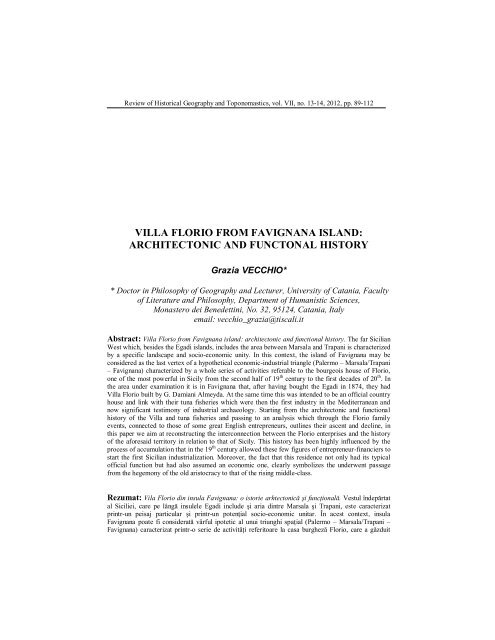
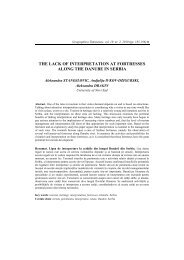
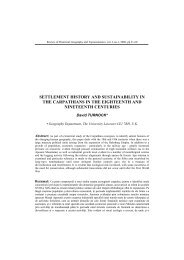
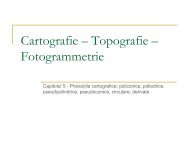
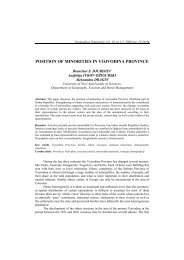
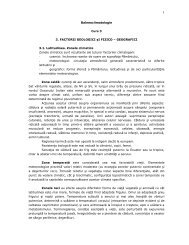
![in Romanian [pdf]](https://img.yumpu.com/51065862/1/184x260/in-romanian-pdf.jpg?quality=85)
